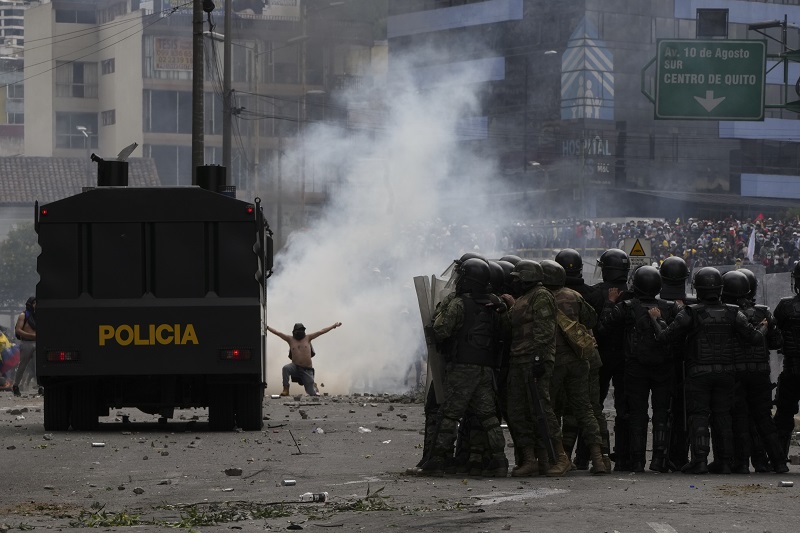Online News Headlines
By Santiago Piedra Silva
Police used tear gas Tuesday to disperse hundreds of Ecuadorans taking part in a ninth day of Indigenous-led fuel price protests that the military described as a “grave threat.” Online News
Some 500 protesters among around 10,000 who arrived in Quito from around the country in recent days were teargassed as they blockaded a street in the capital with burning tree branches.
They quickly regrouped to march on the CCE culture center — traditionally used by Indigenous people to launch protests but requisitioned by police over the weekend to use as a base.
“The objective of today is to retake the Casa de la Cultura,” protester Wilson Mazabanda told AFP before police used spray for a second time to break up the group amid rising tensions and little hope of a negotiated peace.
Earlier Tuesday, Defense Minister Luis Lara said Ecuador’s democracy “faces a grave threat from… people who are preventing the free movement of the majority of Ecuadorans” with widespread road blockades.
Flanked by the heads of the army, navy and air force, Lara warned the military “will not allow attempts to break the constitutional order or any action against democracy and the laws of the republic.”
Called by the powerful Confederation of Indigenous Nationalities of Ecuador (Conaie), demonstrations since June 13 have seen roads barricaded nationwide at a cost of hundreds of millions of dollars to the economy.
Dozens of people, police and civilians, have been injured in clashes.
Prosecutors said they were investigating the death of a young man on Monday who fell into a ravine outside Quito, where demonstrations were taking place.
The prosecutor’s office was also stoned by protesters, and its glass doors were smashed.
Quito Mayor Santiago Guarderas, said on Twitter the demonstrations “continue to escalate” and that the capital’s markets were running out of supplies.
- ‘Tired of this government’ –
Conaie — credited with helping topple three presidents between 1997 and 2005 — called the demonstrations as Ecuadorans increasingly struggle to make ends meet.

Indigenous people comprise more than a million of Ecuador’s 17.7 million inhabitants and wield much political clout, but are disproportionately affected by rising inflation, unemployment and poverty exacerbated by the coronavirus pandemic.
Thousands of protesters, many of whom had traveled to Quito on foot and on the backs of trucks, took to the streets wielding sticks, fireworks and makeshift shields made of road signs.
Headline News Online News
“We are already tired of this government,” said Mazabanda, a university student, of ex-banker President Guillermo Lasso’s one-year-old term.
Tito Zamora, a small-scale farmer, added that costs have risen sharply, “but not the price we get for our products.”
Lasso said on Twitter he was ready to participate in “a frank and respectful dialogue process with Conaie and other civil organizations.”
“It is our duty to reach consensus for the good of the country,” the president said.
- State of emergency –
Fuel prices have risen sharply since 2020, almost doubling for diesel from $1 to $1.90 per gallon and rising from $1.75 to $2.55 for gasoline.
Conaie is demanding a price cut to $1.50 a gallon for diesel and $2.10 for gasoline.
It also wants jobs and food price controls.
The movement has since been joined by students, workers and other Ecuadorans feeling the economic pinch.
Dozens have been arrested, according to human rights observers.
Lasso on Monday extended a state of emergency to cover six of the country’s 24 provinces, with a nighttime curfew in Quito.
Ecuador is losing about $50 million a day as a result of the protests, official figures show, without counting oil production — the country’s main export product.
The CEO of state-owned Petroecuador, Italo Cedeno, told local media on Tuesday that output had dropped by about 100,000 barrels a day during the protests, in part because demonstrators have targeted both oil wells and power plants.
Ecuador’s parliament voted late Monday in favor of a resolution urging the government to conduct a “serious, clear and honest” dialogue with protesters, mediated by the United Nations, Red Cross, universities and the powerful Catholic Church.
In 2019, Conaie-led protests left 11 people dead and more than 1,000 injured but forced then-president Lenin Moreno to abandon plans to eliminate fuel subsidies.
sp/dga/mlr/jh/bgs
© Agence France-Presse. All rights are reserved.
Headlines Online News

Thousands of protesters marched into Ecuador’s capital on Monday, on the eighth day of anti-government rallies. The demonstrations in Quito are led by indigenous people, angry at high fuel prices and demanding social and economic reforms. Footage shows crowds of protesters heading towards the capital on trucks and waving flags, as well as barricades erected on some of the roads. Nationwide demonstrations against President Guillermo Lasso’s economic policies have ramped up across the country in recent days. Lasso extended the state of emergency in six provinces, including a night-time curfew in the capital, as he seeks to quell the unrest. Source: Ruptly.tv
